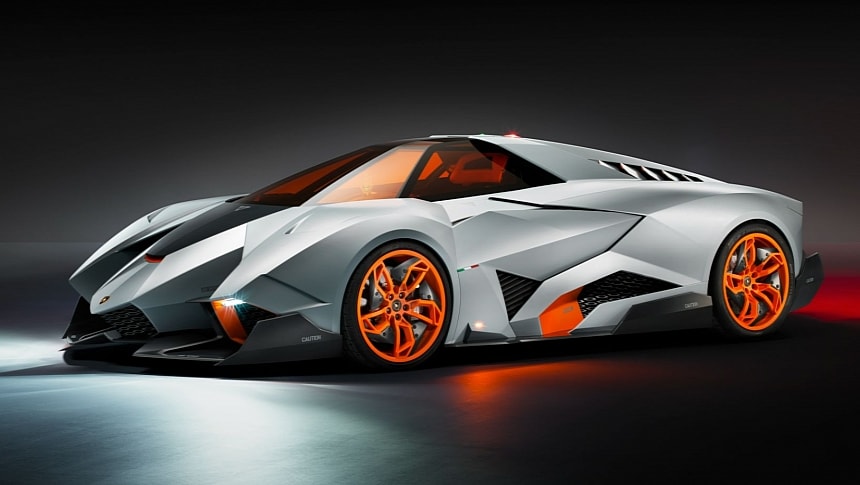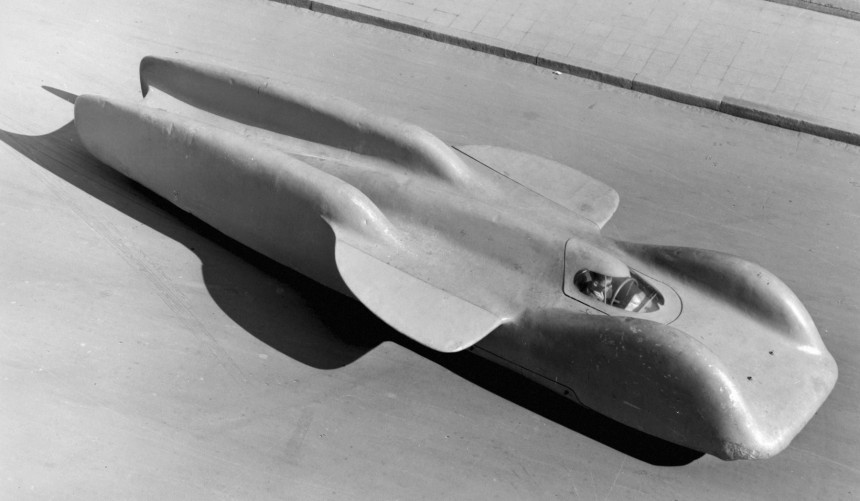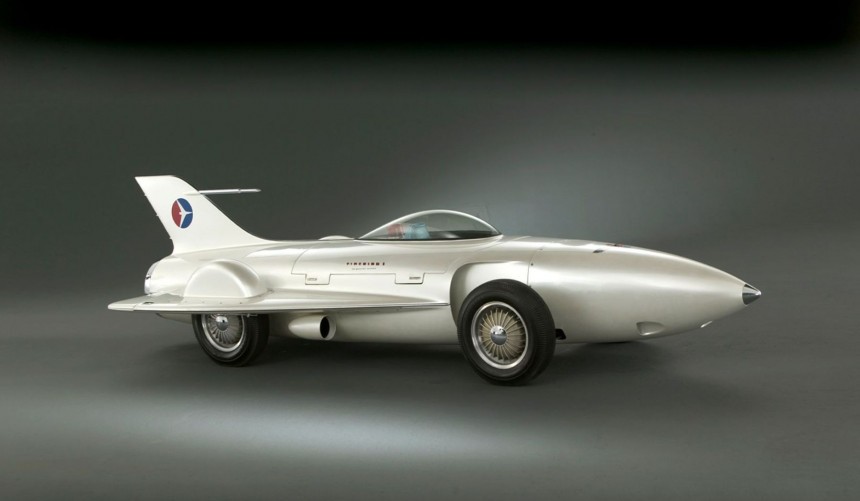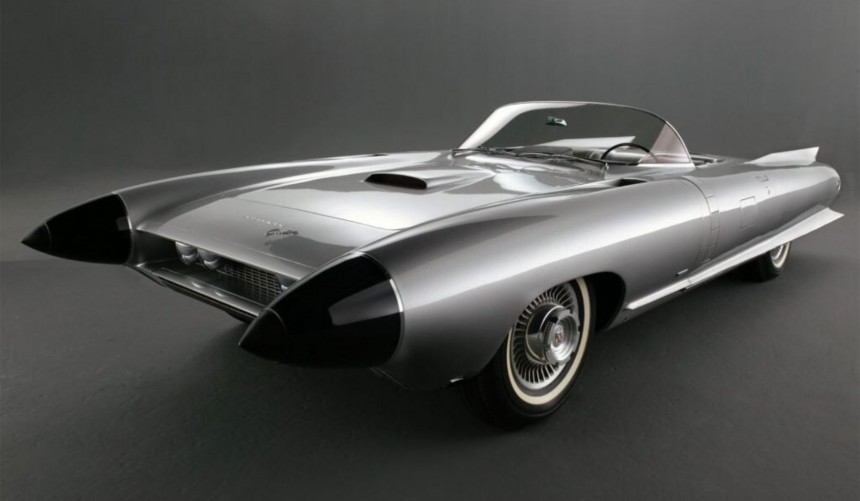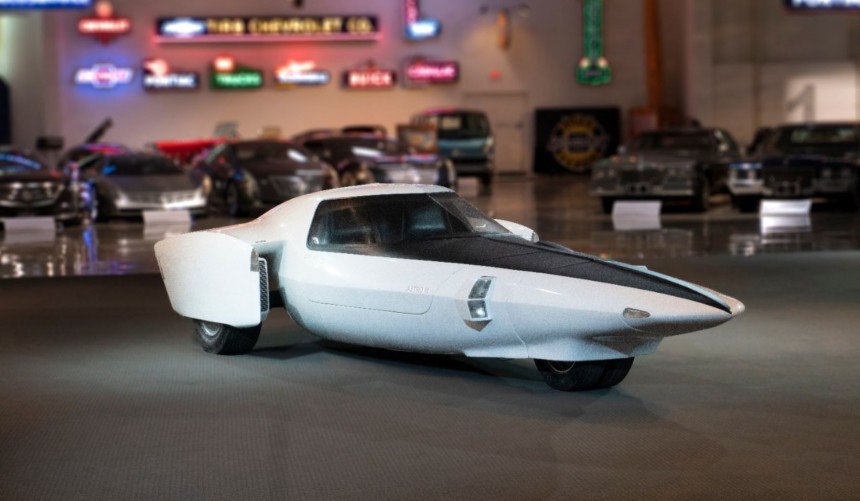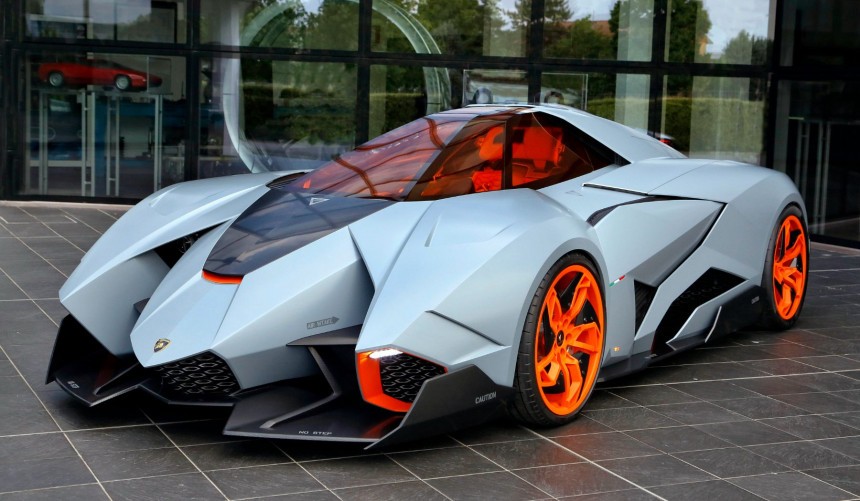The aircraft industry inspired many automotive designs and technologies over the years, but these five concept cars have taken the aircraft-inspired theme to a different level.
Though automotive designers have been inspired by aircraft from the early age of the automobile, shortly after the Second World War ended, the emerging Jet Age had a profound impact on subsequent car designs.
Wings, rounded shapes, and other elements found on aircraft started making their way to cars.
Even jet engines were awfully close to making it into mass production, with the most successful attempt being Chrysler's Turbine car.
However, while pre- and post-Jet Age aircraft designs translated to production cars in a rather subtle way, automakers went to a different level when it came to concept cars.
More than a concept, the T80 was an outrageous six-wheeled vehicle built to set a new land speed record.
The car was designed in the late 1930s by none other than the great Ferdinand Porsche at the request of famed German race driver Hans Stuck.
Built on a complex space-frame chassis and donning a winged body that mixed futuristic race car design with an aircraft fuselage, the T80 was powered by a 44.5-liter Daimler-Benz DB 603 inverted V12.
Derived from the famous DB-601 aircraft engine that powered the Messerschmitt BF 109 fighter, the V12 was allegedly capable of over 3,000 hp.
Unfortunately, the developments of the Second World War put an end to the project, and the T80 never got to break the land speed record.
It remained in the concept stage and, thanks to the efforts of the Mercedes-Benz staff, who restored it to its initial glory, it can now be admired at the automaker's museum in Stuttgart.
For car enthusiasts, the Firebird nameplate alludes to Pontiac's legendary pony car, but it was also used for a series of three aircraft-inspired GM concepts during the 1950s.
Arguably, the most outrageous was the first, dubbed XP-21, which looked like an actual plane on car wheels.
Designed by the legendary Harley J. Earl, who based it on the delta-winged Douglas F4D Skyray fighter jet, the first Firebird received a fiberglass body/fuselage complete with wings, a pointy nose, and a double canopy.
Even more impressive, it was powered by an experimental two-part turbine engine with an output of around 370 hp.
Fully functional, the concept was thoroughly tested, and although it could theoretically reach a top speed of 200 mph (322 kph), no driver was brave enough to push it past 100 mph (160 kph).
As with the Firebird, the Cyclone nameplate is more familiar to muscle car enthusiasts since it was used for Mercury's popular intermediate, which, in GT guise, was a thoroughbred tire-shredder.
However, in 1959, it was used for another Harley J. Earl-designed, aircraft-inspired concept.
Though not as close to a fighter jet as the Firebird XP-21, the Cadillac Cyclone was chock-full of aircraft-inspired features, like the black, warhead-like cones at the front.
Inside those cones, engineers placed sensors that measured speed and detected oncoming traffic or pedestrians, sending audible alerts to the driver. It was an advanced collision avoidance system decades before the feature became commonplace in the industry.
Apart from that system, the Cyclone featured electric sliding doors and a vaporized silver-coated canopy that protected occupants from harmful UV rays.
Subsequently, the canopy was removed, and the concept became a convertible.
Today, the Cyclone is still around, and it can be admired at the GM Heritage Center in Sterling Heights, Michigan.
During the 1950s and 1950s, GM was unveiling more breathtaking concept cars than anybody else in the automotive industry.
Another outrageous, aircraft-inspired show car unveiled by GM during that exciting period was the Chevrolet Astro III Experimental.
Developed under the watchful eye of Bill Mitchell, the Astro III looked more like a futuristic spaceship than a contemporary aircraft.
Though it used four wheels, the two in the front were joined together, making the whole vehicle look like a three-wheeler.
Apart from its unconventional yet low-drag design, the one-off showcased a multitude of advanced features like a closed-circuit television viewing screen mounted on a console, an electric canopy top, and a pistol grip yoke-style steering wheel connected to a power steering box.
Like the Firebird I and the Cadillac Cyclone, the Astro III has survived and is on display at the GM Heritage Center.
Carmaker didn't stop developing aircraft-inspired concepts after the Jet Age concluded, and arguably, the best modern-day example is the breathtaking Lamborghini Egoista.
Unveiled in 2013, the fully functional one-off was based on the mass-produced Gallardo. However, its unique stealth-fighter-like body was redesigned from the ground up by Walter de Silva.
Powered by a 600-hp mid-mounted V10, the Egoista featured a single-seat cockpit topped by a canopy with a HUD-like display that projected fighter-jet-like graphics.
The aircraft-inspired look was made even more evident by a series of active aerodynamic panels that raised and lowered to maintain optimum downforce and stability when accelerating or breaking.
Unfortunately, the Egoista was never meant for series production. For several years, it was displayed at the manufacturer's museum in Sant'Agata Bolognese, but a wealthy collector made an offer that Lamborhini couldn't refuse, so it's currently in private hands.
Wings, rounded shapes, and other elements found on aircraft started making their way to cars.
Even jet engines were awfully close to making it into mass production, with the most successful attempt being Chrysler's Turbine car.
However, while pre- and post-Jet Age aircraft designs translated to production cars in a rather subtle way, automakers went to a different level when it came to concept cars.
1939 Mercedes-Benz T80
The car was designed in the late 1930s by none other than the great Ferdinand Porsche at the request of famed German race driver Hans Stuck.
Built on a complex space-frame chassis and donning a winged body that mixed futuristic race car design with an aircraft fuselage, the T80 was powered by a 44.5-liter Daimler-Benz DB 603 inverted V12.
Derived from the famous DB-601 aircraft engine that powered the Messerschmitt BF 109 fighter, the V12 was allegedly capable of over 3,000 hp.
Unfortunately, the developments of the Second World War put an end to the project, and the T80 never got to break the land speed record.
It remained in the concept stage and, thanks to the efforts of the Mercedes-Benz staff, who restored it to its initial glory, it can now be admired at the automaker's museum in Stuttgart.
1953 GM Firebird XP-21
Arguably, the most outrageous was the first, dubbed XP-21, which looked like an actual plane on car wheels.
Designed by the legendary Harley J. Earl, who based it on the delta-winged Douglas F4D Skyray fighter jet, the first Firebird received a fiberglass body/fuselage complete with wings, a pointy nose, and a double canopy.
Even more impressive, it was powered by an experimental two-part turbine engine with an output of around 370 hp.
Fully functional, the concept was thoroughly tested, and although it could theoretically reach a top speed of 200 mph (322 kph), no driver was brave enough to push it past 100 mph (160 kph).
1959 Cadillac Cyclone
However, in 1959, it was used for another Harley J. Earl-designed, aircraft-inspired concept.
Though not as close to a fighter jet as the Firebird XP-21, the Cadillac Cyclone was chock-full of aircraft-inspired features, like the black, warhead-like cones at the front.
Inside those cones, engineers placed sensors that measured speed and detected oncoming traffic or pedestrians, sending audible alerts to the driver. It was an advanced collision avoidance system decades before the feature became commonplace in the industry.
Apart from that system, the Cyclone featured electric sliding doors and a vaporized silver-coated canopy that protected occupants from harmful UV rays.
Subsequently, the canopy was removed, and the concept became a convertible.
Today, the Cyclone is still around, and it can be admired at the GM Heritage Center in Sterling Heights, Michigan.
1969 Chevrolet Astro III Experimental
Another outrageous, aircraft-inspired show car unveiled by GM during that exciting period was the Chevrolet Astro III Experimental.
Developed under the watchful eye of Bill Mitchell, the Astro III looked more like a futuristic spaceship than a contemporary aircraft.
Though it used four wheels, the two in the front were joined together, making the whole vehicle look like a three-wheeler.
Apart from its unconventional yet low-drag design, the one-off showcased a multitude of advanced features like a closed-circuit television viewing screen mounted on a console, an electric canopy top, and a pistol grip yoke-style steering wheel connected to a power steering box.
Like the Firebird I and the Cadillac Cyclone, the Astro III has survived and is on display at the GM Heritage Center.
2013 Lamborghini Egoista
Unveiled in 2013, the fully functional one-off was based on the mass-produced Gallardo. However, its unique stealth-fighter-like body was redesigned from the ground up by Walter de Silva.
Powered by a 600-hp mid-mounted V10, the Egoista featured a single-seat cockpit topped by a canopy with a HUD-like display that projected fighter-jet-like graphics.
The aircraft-inspired look was made even more evident by a series of active aerodynamic panels that raised and lowered to maintain optimum downforce and stability when accelerating or breaking.
Unfortunately, the Egoista was never meant for series production. For several years, it was displayed at the manufacturer's museum in Sant'Agata Bolognese, but a wealthy collector made an offer that Lamborhini couldn't refuse, so it's currently in private hands.
